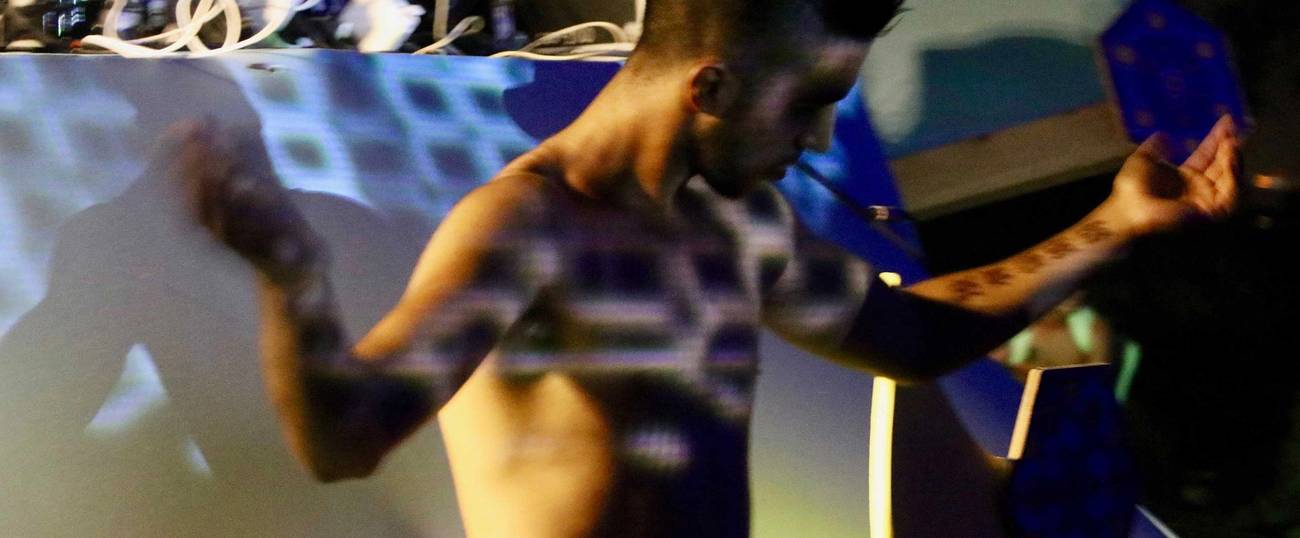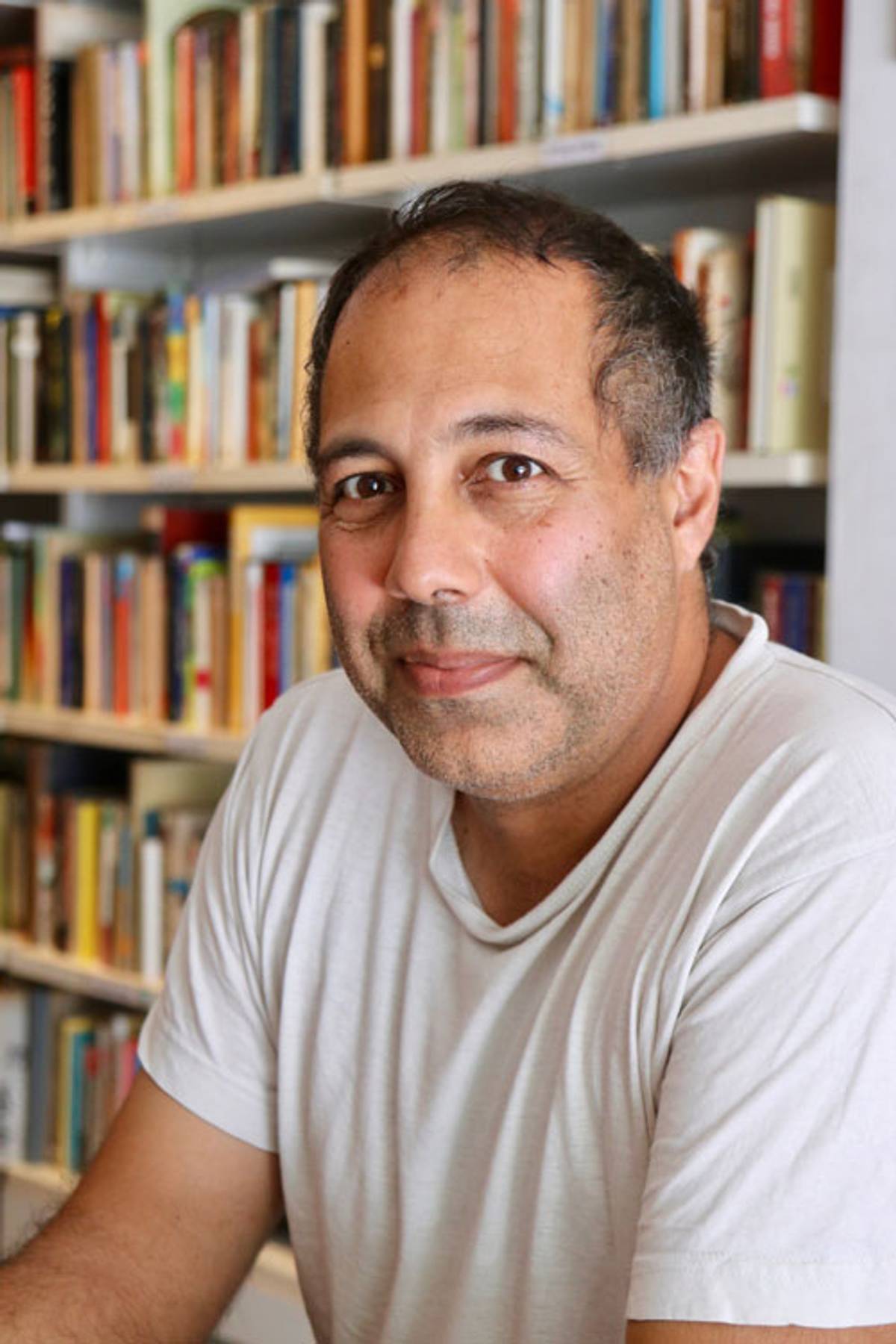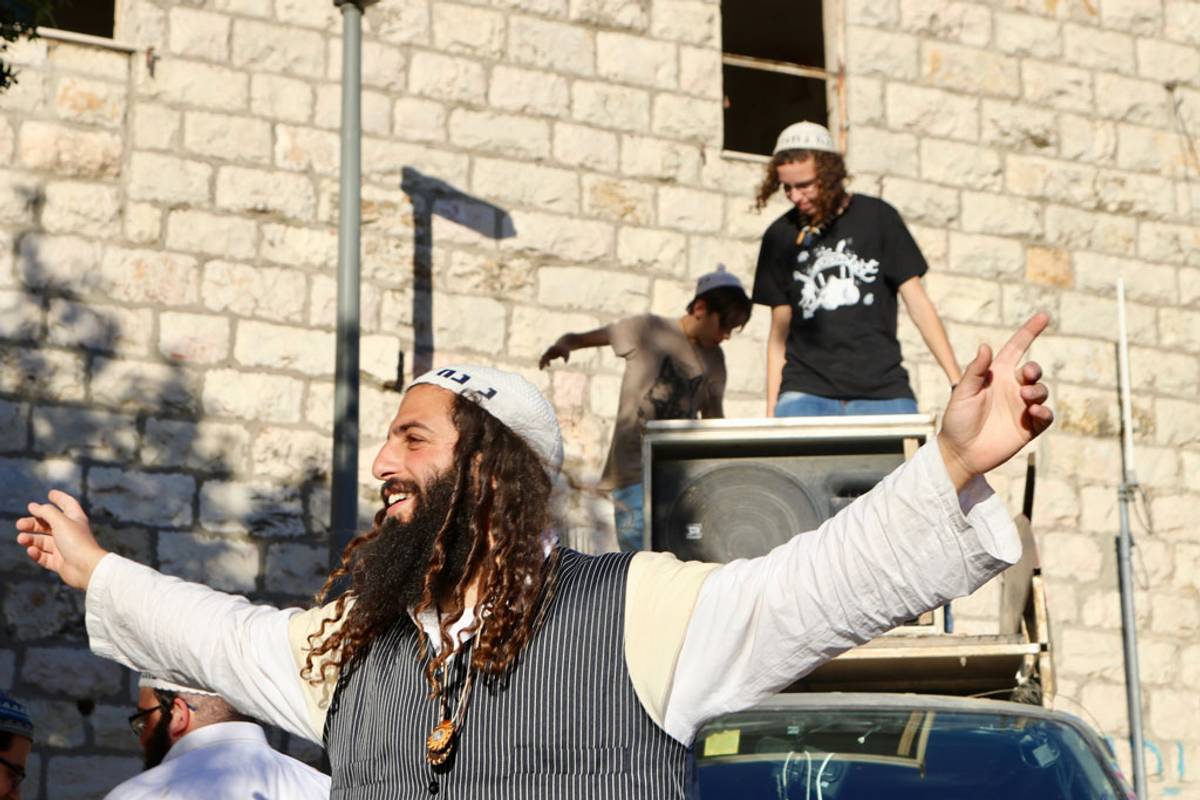Dancing on Common Ground
Psytrance music bridges the divide between secular and religious Jews in Israel




Shahar Zirkin had been driving in circles on a dark, wooded road outside Haifa, until finally, he spotted a piece of toilet paper strung delicately among the branches of a tree. He turned left, driving slowly, looking for more toilet paper “signs” until he could hear thick, subbass frequencies, punctuated with synthesized audio effects in the distance. To the untrained ear, it might have sounded like the soundtrack to an intergalactic space journey; to Zirkin, a DJ-cum-biochemist and founder of Israel’s annual Doof music festival, it was the familiar sound of psytrance—a subgenre of electronic music. As he approached, the beats reverberated through the woods from the underground, neon-lit party, reminiscent of festivals in the Negev desert or in forests up north, or even on the Indian beaches of Goa.
Meanwhile in Jerusalem, Elior Yitzhaky pulled up behind the bustling Mahane Yehuda Market, attracting stares and smiles as he and his cohort of young men hopped out of their van, handpainted with 1970s-inspired swirling rainbows and flowers, and began dancing in the middle of the busy street. The boys’ loose hanging peyos bounced around beneath their large white yarmulkes, crocheted with the Hebrew letters for Na Nach Nachma Nachman MeUman. The mantra is unique to the Na Nach sect of Breslov Hasidim, evoking the name of their rebbe, Nachman of Breslov, who was buried in Uman, Ukraine. A high-tempo electronic melody aptly titled “Happiness” blared through speakers attached to the van’s roof—fitting, given the group’s raison d’être is to spread joy. According to Nachman, the greatest mitzvah is to be happy. At every stoplight, Yitzhaky and the Na Nachs threw open the doors to the van, rushing outside to dance in the streets. As the lights turned green again, they scurried back to their seats and continued on with the joyride.

Zirkin, from secular Tel Aviv, and Yitzhaky, embodying the religious zeal of Jerusalem, could be said to occupy opposite ends of Israeli society. And yet the common ground between them is trance. While their ways of life may seem worlds apart, their affinity for a musical genre that aids in the experience of bodily transcendence, is a shared ritual, and one that is uniquely Israeli.
The hypnotic, pulsing, and at times unpredictable rhythm of trance music, and specifically psychedelic trance—aka psytrance—has a way of arresting the minds of listeners, helping those who enjoy the genre to let it all go. Psytrance can be rapacious and complex, an invitation to dance off the same kind of angst as punk rock, but more hippie than hardcore.
“Israeli people live under loads of pressure,” said Zirkin. “Psytrance is quite big in Israel because we use it as a pipe to connect to something else, and to release this pressure.”
This pressure in part stems from the Israeli youth experience in the IDF, and from the complexities of living amid perpetual conflict. Back in the late ’80s, thousands of Israelis who had just finished their obligatory military service discovered the trance genre on the beaches of Goa, India. There, the combination of music and psychedelic drugs (up to 90 percent of IDF veterans in India use cannabis and other drugs) has since helped Israelis process the remaining stress of the army and life at home. Meanwhile, musical legends like Goa Gil, a Californian Jew-turned-Hindu, used synthesizers and the like to electrify the psychedelic jam session, luring in minds and ears as jam bands much as the Grateful Dead had done acoustically only a decade or two earlier with hours-long, drug-induced musical sets.

Popular among both secular and religious Israelis, psytrance is its own type of creed—spiritual, if agnostic. “You get into this trancey kind of experience. You feel like you’re not part of the lower world anymore and you’re one level up,” said Zirkin. “Psytrance gives you the ability to change the awareness of your mind.”
The Israeli connection to trance really got going in the ’90s, Gil explains, as artists like the Infected Mushroom and Astral Projection gained popularity around the globe. He describes the genre as an “an ancient tribal ritual for the 21st century,” and the dance that goes with it “an active meditation.”
“When we dance, we go beyond thought, we go beyond the mind to become one with the cosmic,” said Gil. “It’s that experience of oneness with the whole environment around you.”
That environment, most often, is in nature—hence the desert or forest parties now quintessential of the psytrance party scene in Israel. It didn’t take long for the genre to take root in the Middle East as DJs like Zirkin began producing trance music festivals. Starting around 1995 as an underground party in the Negev drawing fewer than 500 people, the Doof festival blossomed into a now-permitted annual festival of about 8,000. Other parties are even bigger, such as up to 12,000, says Zirkin, sometimes running three days straight. It’s all in the name of that release. Doof’s tagline reads: “Everybody needs a place where they can go insane peacefully.”
Around the same time that trance first became popular among Israelis, a rogue sect of hippie Hasidim was developing: The Na Nach movement took off a bit prior to and following the death in 1994 of Breslover Rabbi Yisroel Ber Odesser, or endearingly known as Saba (Hebrew for grandfather).
According to Na Nach belief, Saba received a note in 1922 from the long deceased Rebbe Nachman (1772-1810). The Petek, as the note is called, included the well-known phrase “Na Nach Nachma Nachman MeUman,” which Saba’s followers—the Na Nachs—have tagged all over the walls of the country.

Toward the end of Saba’s life, a number of baalei teshuva (secular Jews who have returned to faith) became attracted to his and Nachman’s teachings. Among those teachings was an emphasis on hitbodedut, or solitary meditation in nature, communing with and crying out to God. To more conventional Hasidim, so much solitary prayer (as opposed to the more traditional 10-man minyan, or prayer group) would drive one insane—but for the Na Nachs, perhaps that’s just the point: a peaceful insanity, not altogether different from the insanity found in nature parties and espoused in Doof’s tagline.
“Na Nach is a kind of understanding of the world,” according to Aryeh Tzion, himself a Na Nach. “Rebbe Nachman said to release the mind, so there is something in trance that releases the mind.” Saba had told his followers to take vehicles and go around dancing at stop lights, to put up Na Nach signs everywhere, to go house-to-house distributing Breslov literature, to disseminate the Rebbe’s teachings, and to spread joy. He also said to dance, since moving the body is another avenue to happiness. Nachman himself had struggled with depression—which is why for him, joy was such a significant aspiration.
The Na Nachs’ low barrier to entry, along with the sect’s accepting, free-spirited character, have attracted a number of baalei teshuva, including those like Yitzhaky and Tzion. For these once-secular Israelis, trance is an entry point into the Na Nach way of life.
“We are a generation of trance,” said Tzion. “Before I tried to believe, I found trance. And when I heard trance with religious people, I felt comfortable because it was the same as before.” Not only an entry, trance is also a point of return: “Go where you had been before you did teshuva, to the place where you made the sin, go back there and go fix it.” For Na Nachs who came of age along with psytrance, returning to familiar music from the vantage point of their new religious way of life is an opportunity for that teshuva, or atonement for past sins. Rebbe Nachman also teaches to take the clothes of the outside world, to capture that light and make it Jewish, make it your own, Tzion added, and that’s just what the Na Nachs have done with trance.

At once a spiritual release and an entry point into an elevated state of mind, trance can serve as a type of therapy, according to psytrance DJ Avishag Bornstein, who was born into an Orthodox family in Jerusalem before reinventing herself as DJ Shugi Born. “Before I come to play, I feel so sad sometimes,” she said. “But when I’m on stage I feel my power and energy coming back. I feel better. I’m dancing, I’m clean, and I feel everything.”
Israeli Jews aren’t the only ones who have been taken under the spell of trance. In New York’s Catskill Mountains, an annual festival by the name of Palm Shtrimpin seeks to also provide a musical means of spiritual transcendence. The camping getaway is replete with challah, wine, kegs full of gefilte fish, and nonstop psytrance—except on the Sabbath, since the festival is a shomer shabbos experience. It’s attended by Jews of all stripes and colors, those who’ve retained their peyos, those who’ve gone so far as to get tattooed, and everyone in between.
For ex-religious Jews like Bornstein, along with secular Israelis, their love for trance is a counterpoint to the Na Nachs’ adoration for it. For these groups, psytrance is part and parcel to shedding a religious way of life, versus adopting one. Essentially, it’s the other side of the same coin: For everyone, it equals liberation, but from what and toward what is more subjective.
At its core, it’s an escape—whether it be from the pressures of life in the Holy Land, adherence to a holy lifestyle, or even the irreverent humdrum of the mundane—before breaking free into someplace more spiritual. Imbuing a “secular” genre with a kiss of the sublime, atheists and believers alike agree the music may even be holy unto itself.
***
Like this article? Sign up for our Daily Digest to get Tablet Magazine’s new content in your inbox each morning.
Jenna Belhumeur is a Berlin-based journalist, covering refugees and club culture. Madison Margolin is a Los Angeles/New York-based journalist, covering cannabis and Jewish life.